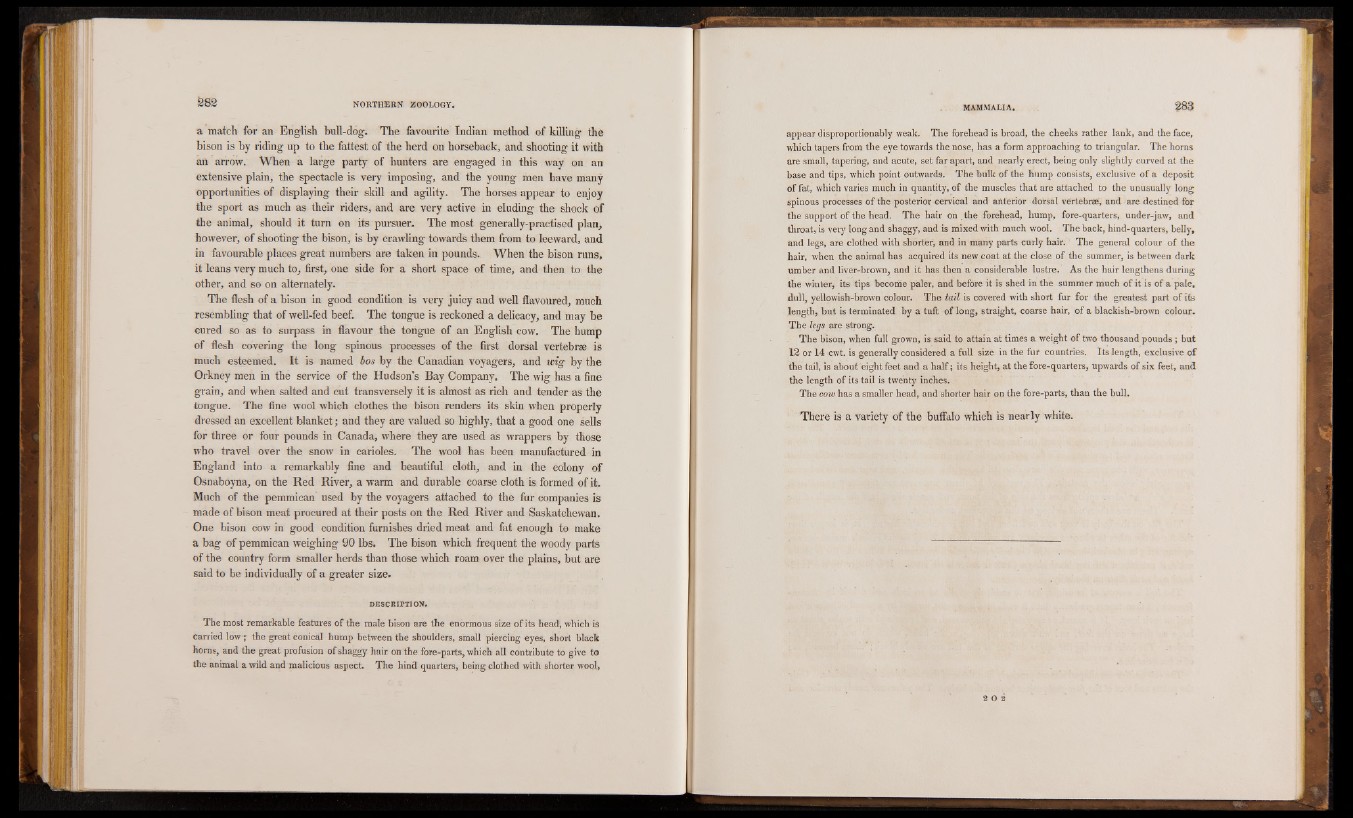
a match for an English bull-dog. The favourite Indian method of killing the
bison is by riding up to the fattest of the herd on horseback, and shooting it with
an arrow. When a large party of hunters are engaged in this way on an
extensive plain, the spectacle is very imposing, and the young men have many
opportunities of displaying their skill and agility. The horses appear to enjoy
the sport as much as their riders, and are very active in eluding the shock of
the animal, should it turn on its pursuer. The most generally-practised plan,
however, of shooting the bison, is by crawling towards them from to leeward, and
in favourable places great numbers are taken in pounds. When the bison runs,
it leans very much to, first, one side for a short space of time, and then to the
other, and so on alternately.
The flesh of a bison in good condition is very juicy and well flavoured, much
resembling that of well-fed beef. The tongue is reckoned a delicacy, and may be
cured so as to surpass in flavour the tongue of an English cow. The hump
of flesh covering the long spinous processes of the first dorsal vertebrae is
much esteemed. It is named bos by the Canadian voyagers, and wig by the
Orkney men in the service of the Hudson’s Bay Company. The wig has a fine
grain, and when salted and cut transversely it is almost as rich and tender as the
tongue. The fine wool which clothes the bison renders its skin when properly
dressed an excellent blanket; and they are valued so highly, that a good one sells
for three or four pounds in Canada, where they are used as wrappers by those
who travel over the snow in earioles. The wool has been manufactured in
England into a remarkably fine and beautiful cloth, and in the colony of
Osnaboyna, on the Red River, a warm and durable coarse cloth is formed of it.
Much of the pemmican used by the voyagers attached to the fur companies is
made of bison meat procured at their posts on the Red River and Saskatchewan.
One bison cow in good condition furnishes dried meat and fat enough to make
a bag of pemmican weighing 90 lbs. The bison which frequent the woody parts
of the country form smaller herds than those which roam over the plains, but are
said to be individually of a greater size.
DESCRIPTION.
The most remarkable features of the male bison are the enormous size of its head, which is
carried low; the great conical hump between the shoulders, small piercing eyes, short black
boms, and the great profusion of shaggy hair on the fore-parts, which all contribute to give to
the animal a wild and malicious aspect. The hind quarters, being clothed with shorter wool,
appear disproportionably weak. The forehead is broad, the cheeks rather lank, and the face,
which tapers from the eye towards the nose, has a form approaching to triangular. The horns
are small, tapering, and acute, set far apart, and nearly erect, being only slightly curved at the
base and tips, which point outwards. The bulk of the hump consists, exclusive of a deposit
of fat, which varies much in quantity, of the muscles that are attached to the unusually long
spinous processes of the posterior cervical and anterior dorsal vertebrae, and are destined for
the support of the head. The hair on . the forehead, hump, fore-quarters, under-jaw, and
throat, is very long and shaggy, and is mixed with much wool. The back, hind-quarters, belly,
and legs, are clothed with shorter, and in many parts curly hair. ' The general colour of the
hair, when the animal has acquired its new coat at the close of the summer, is between dark
umber and liver-brown, and it has then a considerable lustre. As the hair lengthens during
the winter, its tips become paler, and before it is shed in the summer much of it is of a pale,
dull, yellowish-brown colour. The tail is covered with short fur for the greatest part of its
length, but is terminated by a tuft of long, straight, coarse hair, of a blackish-brown colour.
The legs are strong.
The bison, when full grown, is said to attain at times a weight of two thousand pounds ; hut
12 or 14 cwt. is generally considered a full size in the fur countries. Its length, exclusive of
the tail, is about eight feet and a half; its height, at the fore-quarters, upwards of six feet, and
the length of its tail is twenty inches.
The cow has a smaller head, and shorter hair on the fore-parts, than the bull.
There is a variety of the buffalo which is nearly white.